[…] Continue reading here: Do You Have the Skills to Succeed? » The Rapid eLearning Blog […]
Do You Have the Skills to Succeed?
March 20th, 2012
In a recent post, I shared my recent webinar with the E-Learning Guild and some of the conversation we had around rapid elearning.
In today’s post we’ll look at another part of the conversation where we discussed what skills are needed to succeed and how they can be nurtured.
Rapid E-Learning Developers Wear Many Hats
When I first started with elearning we’d have a team of people working on projects. Someone did the instructional design, someone else worked on graphics, and then we had a programmer who built the courses in Authorware or some other application.

That’s usually not the case today. Most of the people I talk with usually work by themselves and mostly responsible for all parts of the course development from content design to the graphics and then the conversion to elearning.
While today’s software has made the job easier, but it’s also made it more challenging for the person who has to develop and deliver elearning courses.
Success Requires Multiple Skills
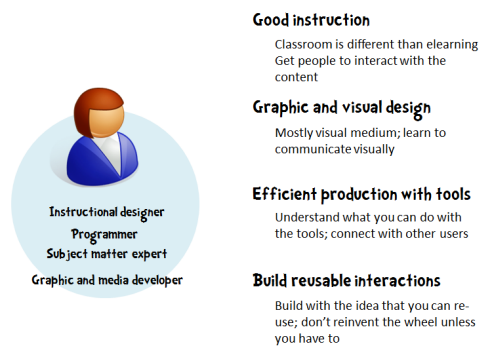
Since so much of the development of the elearning course sits on the shoulders of just a few, it’s important to have multiple skills. Here are some of the skills that are critical to success:
- Project consulting. This combines project management and performance consulting so that the project is focused on the right things and moving in the right direction.
- Instructional design. It’s important to understand how people learn and how to build good elearning experiences.
- Visual design. Elearning is a mostly visual medium, so it makes sense to understand how to craft the visual experience that works best with the course content.
- Experience design. Learn to build a great user experience. This is a combination of user interface design and graphic design. It’s all about creating an environment that facilitates the best learning experience.
- Expertise with your authoring tool. Regardless of the authoring tool you use, you need to become an expert using it. The tools are getting easier, but unless you learn to really use them you probably won’t go past basic course design.
- Understand common elearning technologies. “Multi” is the key part of multimedia. There are many technologies that make up good elearning—audio, video, graphics, and web technologies. HTML5 and the iPad are ushering even more considerations. You don’t need to be an expert, but you should be familiar with the basics.
Acquiring Skills
One you understand the skills you need, the next step is figuring out how to acquire them. We’ll explore a few ways here, both formal and informal.
Formal education. The most common expectation is to acquire them through some sort of formal education. In a previous post we discussed whether or not you need an instructional design degree.
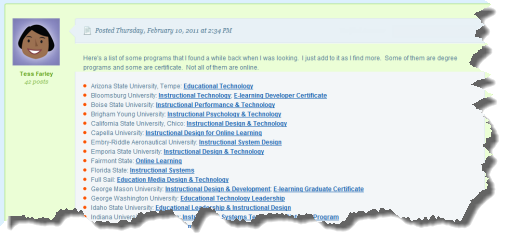
If you’re looking for formal education on instructional design, we started to compile a list of degree and certificate programs in the elearning community. There are also some good comments about the experience in the forum thread.
Informal education. I think getting a formal education is good and will open many doors. At a minimum, it lets you compete for jobs where having a degree is required. However, there’s a difference between a degree in instructional design (which can be broad) and gaining the skills to build good elearning courses.
You’ll definitely need to augment your formal education with informal activities.
Free tutorials. In this day and age there are all sorts of resources available to learn more. Want to learn PowerPoint? There are thousands of tutorials on sites like Youtube and Screenr. Here are two good posts that cover most of what you need to know about PowerPoint for elearning:
- More Than 30 PowerPoint Tips from the PowerPoint Pros!
- More Than 100 PowerPoint Tutorials & a Free Template
That’s just the tip of the iceberg. If you’re an Articulate user, the community offers hundreds of great how-to tutorials. There’s even a generic course on how to take a PowerPoint file and convert that to an elearning course. And those tips work regardless of the tools you use.
Of course, elearning isn’t limited to PowerPoint. The point is that if you want to learn then you’ll find a lot of free resources that help.
Read Books. There are many good books to help you get started. I’m sure everyone has a favorite. I started a list of books in the elearning community, but here are the most common that I usually recommend:
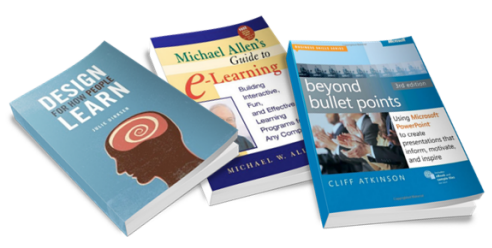
- Performance Consulting: help clients focus on the right goals and performance outcomes.
- Design for How People Learn: a good overview of how people learn—perfect for those who are just getting started.
- Beyond Bullet Points: combines cognitive science from Mayer with practical steps on creating a meaningful presentation.
- Non-Designer’s Design Book or Non-Designer’s Design & Type Books: good books on the basics of graphic design and use of font
s. - Understanding by Design: start with your objectives in mind and figure out how to teach to them and assess the learner’s understanding.
- E-Learning by Design & Michael Allen’s other stuff: classic information from one of the pioneers of elearning.
The links to Amazon books may produce a slight commission.
Real World Experience
A formal degree is only going to help you. But odds are you won’t learn enough to acquire all of the skills you need to get really good at this elearning thing. And you can only learn so much from reading and viewing tutorials.
At this point you have to get your feet wet and work on real projects. Most of the skills you need come from experience. And you only get the experience by working on projects and over time.
In an ideal world, you get to work on a variety of projects that will enhance your skills. But the reality for most people is that they work on the same types of projects over and over again. So they may have built 100 elearning courses, but basically they built one type of course a hundred times.
It’s up to you to get the diversity you need. Here are a few tips:
- Make it a habit to review good elearning courses and multimedia examples. Then document what you like and try to work some of those things into different projects. This is a great way to develop your skills and push the envelope a bit at work.
- Create before and after examples of good elearning. If you want to build more engaging courses at work, then convert one of the typical courses into something more engaging. Use that to show your organization the types of courses you should be building. People respond to good examples.
- Create a personal portfolio. Some organizations will stifle your development. If that’s the case, then build a portfolio to practice different things. They don’t need to be big courses. For example, create ten different ways to navigate without a next button. This lets you practice ideas on a small scale and document your skills.
- Volunteer. There are a number of opportunities to volunteer to build courses for others. LINGOs is always looking for help. And you may even get some recognition. Try local community groups like churches or the YMCA. I’m sure they’d love to put your skills to good use.
Stay Connected to the Industry
Years ago if you wanted to meet industry experts you had to go to trade conferences or workshops. And even then, did you really get to “meet” them?
Today, it’s so much easier. The online communities and social media tools make it easier than ever to connect with others. And here’s the thing about experts—we’re all experts, just at different levels. Even if you’re just getting started, your questions and fresh perspective help frame our understanding in new ways. You’re the fuel that keeps the community vital and growing.
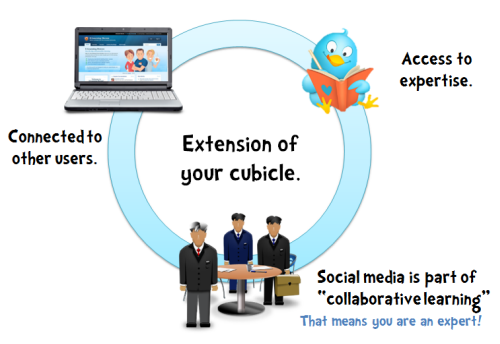
In a practical sense, the online community is going to offer all sorts of help. It curates all of the latest news. It also shares expertise and offers free resources. Software vendors like Articulate make the tools to use, but it’s the community of users who develop the best practices and tricks to get the most out of them.
I see the community as an extension of your cubicle. Going forward your value to the organization is in large part going to be dictated by how well you’re connected to your industry peers. The person who is connected and knows where to find the help and resources is going to always have the advantage.
Like I stated earlier, the tools are getting easier to use, but that also places more pressure on you to have multiple skills. The opportunities to acquire them exist, even if you’re on a budget. You just have to be intentional about getting them.
How did you learn what you know? Did getting a degree help? Do you participate in a community or social media? We’d love to hear your thoughts. Share them by clicking on the comments link.
Events
- Everyday. Check out the weekly training webinars to learn more about Rise, Storyline, and instructional design.
Free E-Learning Resources
 |
 |
 |
|
Want to learn more? Check out these articles and free resources in the community. |
Here’s a great job board for e-learning, instructional design, and training jobs |
Participate in the weekly e-learning challenges to sharpen your skills |
 |
 |
 |
|
Get your free PowerPoint templates and free graphics & stock images. |
Lots of cool e-learning examples to check out and find inspiration. |
Getting Started? This e-learning 101 series and the free e-books will help. |
27 responses to “Do You Have the Skills to Succeed?”
Great article Tom.
For me, the one thing that a good ID should possess is *real-world* experience of business or the area they will be creating the course for.
That does not mean just questioning the SMEs/content providers, but getting out into the “community”, speaking to the learners, and if possible having an all-round business background.
If you are creating courses to solve (business) issues, it’s only reasonable you have some experience of the reality of that area, not just experience of what people tell you are the issues in that area.
Bruce
Great Post Tom. It touches on something I’m working on right now.
So let’s say I’ve got a group of instructional designers on my team, and I’m looking for a way to test their ID and rapid development skills. We want to ramp everyone on the team up to a certain skill level. Do you know of any good quizzes or exams I could use so I can start to create a benchmark for skill development in my department? For a long time, I’ve looked for a generic “What do you know about ID and rapid design” kind of knowledge test, and I can’t find it. Any ideas?
Thanks
Mitch
Tom:
Thanks for this discussion, I have been trying to explain to a group of county coordinators what skills and knowledge are necessary for what I do. As a one-person, does all position, it is difficult to explain exactly what I do. They have always been delighted with the outcomes, but are unaware of the magic that goes into getting there.
All they know is what they want done is the most important thing and that it needs to be done fast. As the content developer along with all the other hats that I wear it is not always possible to met all their demands, as fast as possible.
So, I took your “Do you Have the Skills to Succeed?” and printed it out to hand to everyone at meetings, etc. Perhaps then they will be also awed by the outcomes when they see all of the skills that go into the creation.
I have no formal training in design, but started with good writing skills and got the opportunity to develop a new employee training course from scratch. The first edition leaves a lot to be desired, but it is still in use. I used some ideas from this blog, like pulling vs pushing, and scrounged for other ideas. I think this post has some great tips for expanding one’s skills beyond the everyday.
Tom,
Great Post, In fact Awesome post! Being the CEO/Cheif E-Learning Officer of 2E Educational Services, I had to perform all those roles you listed in your discussion for effective e-learning course. I will keep this in my library for aspiring rapid e-learning developer. Great work bro
Great post…. thanks Tom!
Like many others in this profession I most often work as a “one man (or woman) band”.
BTW…. As this is my second “new” career I find it the most challenging… and the most rewarding.
I like Lynda.com
It has 100’s of professional, online training courses on a multitude of software.
Another important thing to do is to stay aware of the most current technology and software that is available. I find that it is very helpful to occasionally search the job boards for new job postings. Browse the postings and look for the software that they require experience with. Many times, you will see certain software that is gaining in popularity. I have used this technique to discover many new programs that I would have never heard about otherwise.
Great post – that’s me too.
My tips for newbies (and for people looking to change companies where they can’t actually display content that is sensitive) is to design an eLearn course for something that every company or every company in your target industry would need. Look for induction training or training that is mandated by legislation.
For example, in Australia, the magic three are:
1 Occupational Health & Safety (OHS) in the workplace
2 Diversity
3 Equal Opportunity
If delivery to key industry, you can then pick some key topics that you probably have already developed or delivered. For example, my background is Finance, Call Centres and RTOs. I have a suite of materials that I’ve collected over the years that can easily be turned into eLearning or already has been.
The benefit of this is that it gives me a portfolio to display. I actually have my OHS module formatted several different ways to show off my design skills.
It’s also allowed me to walk into new roles and get some quick wins by adjusting material that I already have to meet the new employer.
Really enjoyed this, thanks Tom.
We speak to lots of training providers who have been delivering training in other formats, and want to jump in to the elearning world.
Too often it’s seen as a quick buck instead of a valuable educational tool, and lots think they can create their own with very little effort.
I think this hits the nail on the head though – you need to be interested and inspired, with a good understanding and skills you’ve learned through actually creating elearning systems. Attending a relevant workshop is a great start, the rest comes with effort.
That hit the spot Tom.
In my part of the world it is very difficult to find people with any experience in learning design. My challenge is hiring folks who have the right foundation for me to build on. You mentioned Instructional Design, Tech-savvy, Visual Design and Subject Matter Knowledge as the key skill areas. I am wondering whether someone can help me answer the big question:
Which one of these takes the minimum amount of time to teach?
So if I hire someone with good understanding of visual design, will it be easy to teach them ID and develop an adequate understanding of technology within 3 months? Or do I look for someone who is tech-savvy and teach them the rest of the skills?
Hi, interesting article, was particularly interested in the volunteering section. I’m just concerned I don’t know enough about Articulate to rush in and offer my services and therefore why would they bother to use me?
Also a marketing guy who sends me his newsletter has mentioned in that that he is thinking of writing a course. I was going to jump in and say, have you thought about…but again why would he be interested in using me? Do I offer my services for nothing just to get started?
Thanks so much for the post Tom. Very timely for me as I am considering starting my own business and have been thinking about the skill set I would need. This provides me with a great outline.
I currently have a small contract to produce some learning objects for university undergraduates and all many people seem to want from eLearning components is Flash animations, which is a problem for me on several levels. If only they understood how much more was involved in producing great learning experiences.
[…] Do You Have the Skills to Succeed? […]
Thanks, Tom!
This post was just the summary I needed today to give me some direction for what I want to do going forward for my own learning and development. I just got back from Learning Solutions (very sad that I never made it over to meet you!), and I’m currently feeling “consciously incompentent.” But hey – I’ll take that over unconscious incompetence any day. I’m excited to start learning the things I now know that I don’t know, and I’m hoping to start a blog and portfolio to track my progress.
Thanks again for the wonderful tips you share! The comments and insights from others are also much appreciated.
~Tessa
Where are some good sites to see examples of great e-learning courses?
[…] o mujeres de negocios; mientras que en The Rapid Learning Blog Tom Kuhlman nos ayuda a descubrir si contamos con las competencias para asumir este papel dentro de las organizaciones. Cierro el tema invitándolos a leer el artículo What will your […]
Hi Tom,
Good article. But I do have a concern here. I am a Instructional Designer from Automobile background. So I used to do projects specifically for Automobile projects. The storyboard was done using excel templates. Now that I joined a new Organization, most of the projects are done using MS word and power points which I was less familiar with it and I screwed up.
Right now the current project I am working on is
Producing a VILT session using Adobe connect platform. In the mean time I am not getting any other projects to work on in order to improve my skills nor any trainings, so I am trying hard to figure out how I can learn ” Instructional Designing’ by myself online.
Kindly help.
[…] read the full article, visit Tom Kuhlmann’s blog here. For an extended list of helpful books, click here. This entry was posted in Good Reads, Out in […]
[…] for some good summer reading? Tom Kuhlmann, author of The Rapid E-Learning Blog, put together this list of his favorite elearning books to boost your skillset and give you a fresh […]
Hi folks,
After reading many of the wonderful responses and suggestions, I decided to offer my two cents. I graduated with a Master’s in Instructional Design 3 years ago. I was juggling a brand new full time job and trying to graduate successfully. It was extremely challenging and stressful, to say the least, but I did it. In my senior year, I got to participate in a graduate level practicum that helped to create a CBT program for a real company. It was an intense project, from creating storyboards to doing needs assessments, creating learning objectives, meeting with SME’s, research, selecting graphics, alpha and beta testing, etc.
It was a great experience. I made some mistakes during that process, but I also really learned from those experiences and know that I can be a great instructional designer. Should I try to find a position as a junior ID with my limited experience? I’m also trying to do some volunteer work, but it’s challenging. Any opinions, feedback?
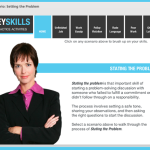







0
comments